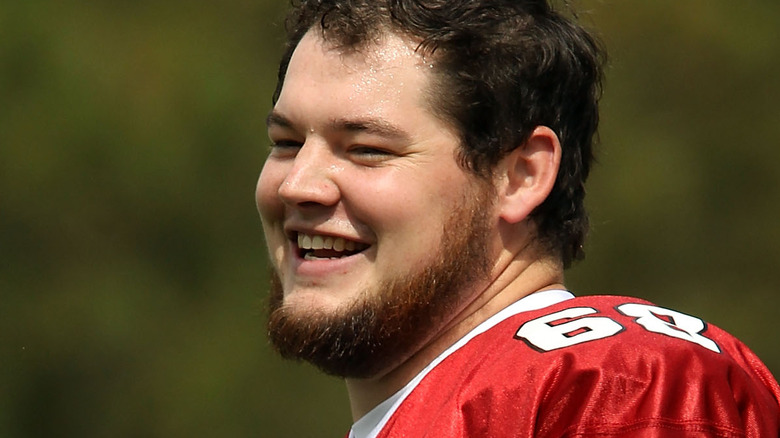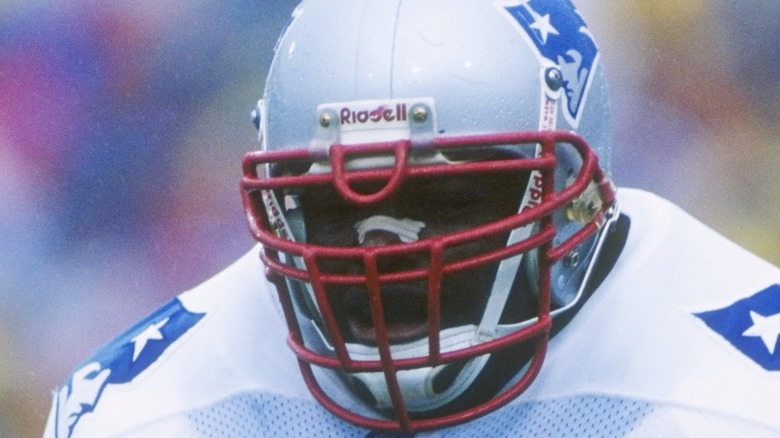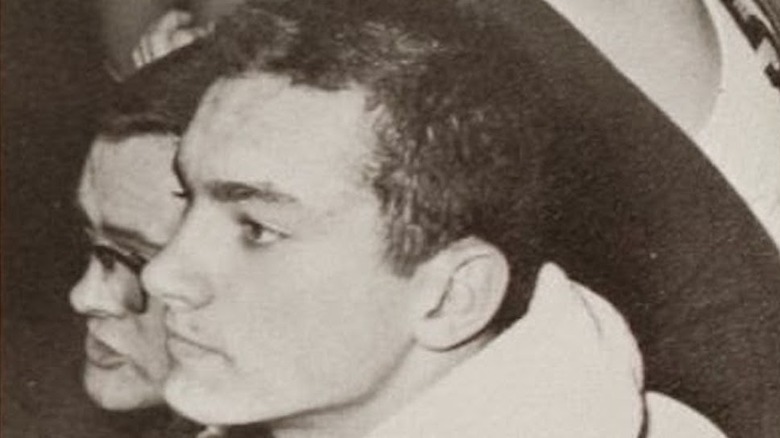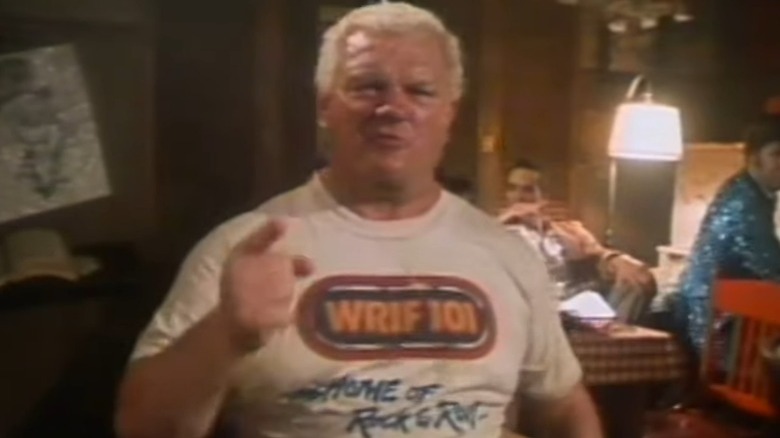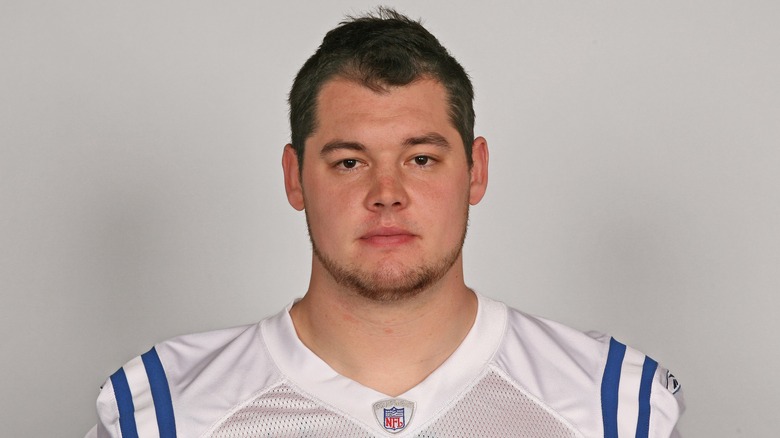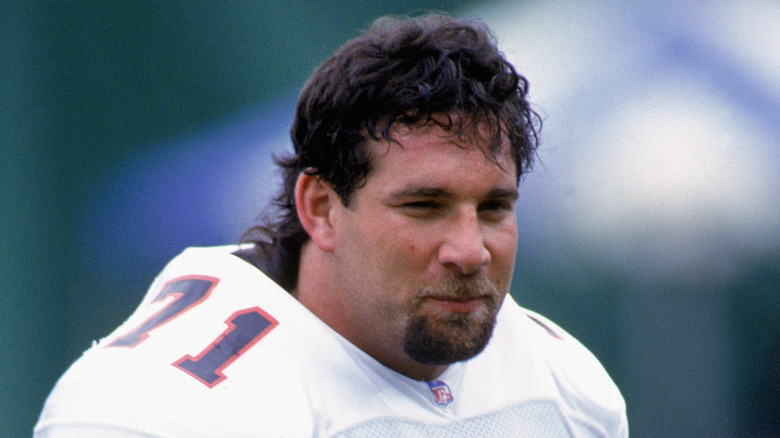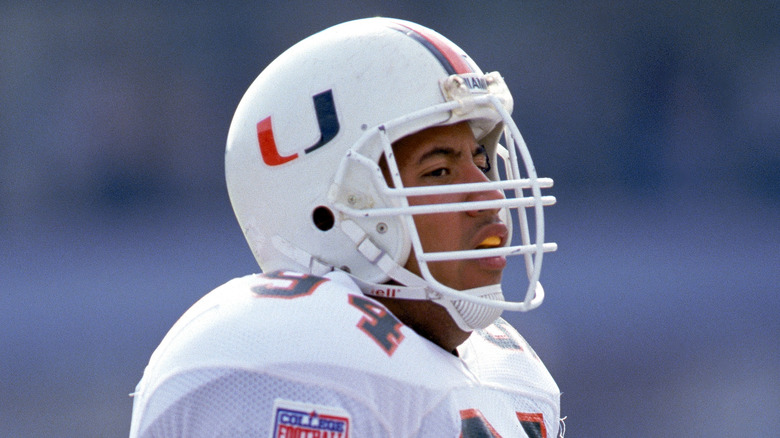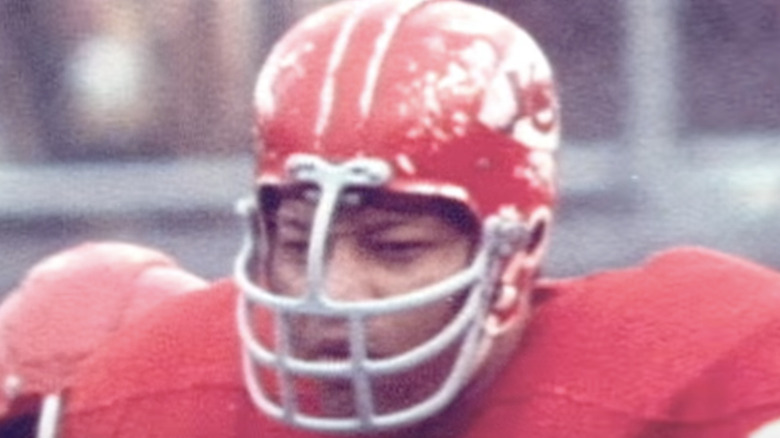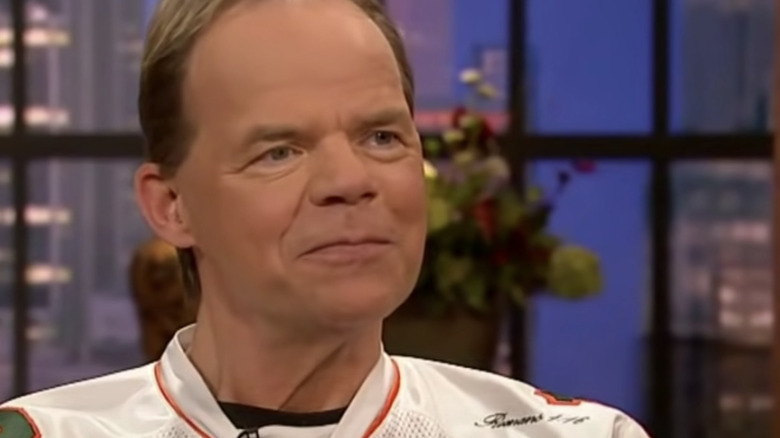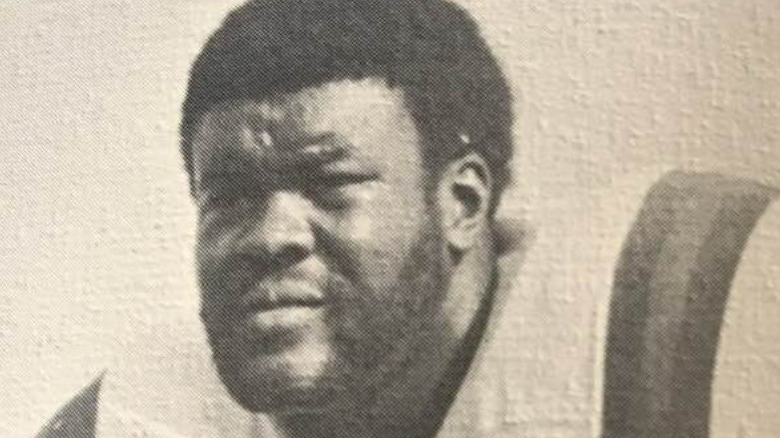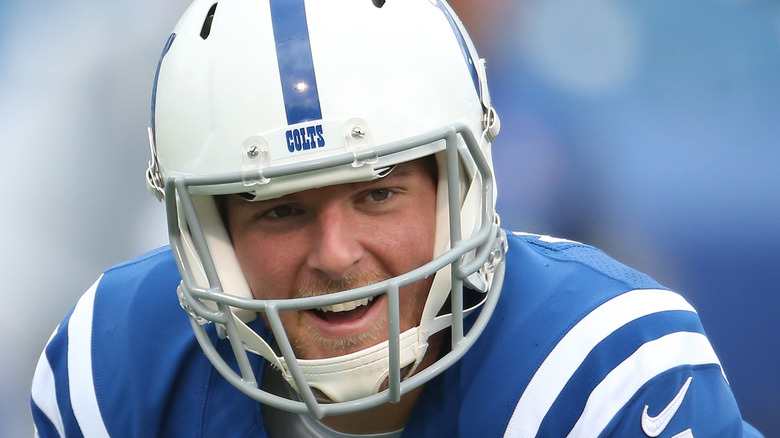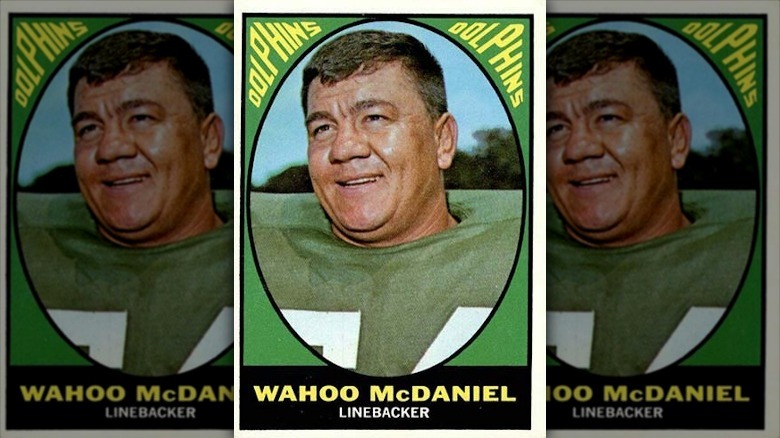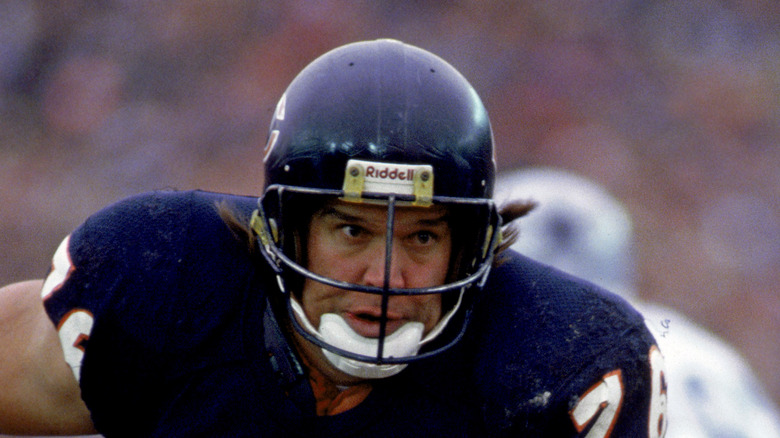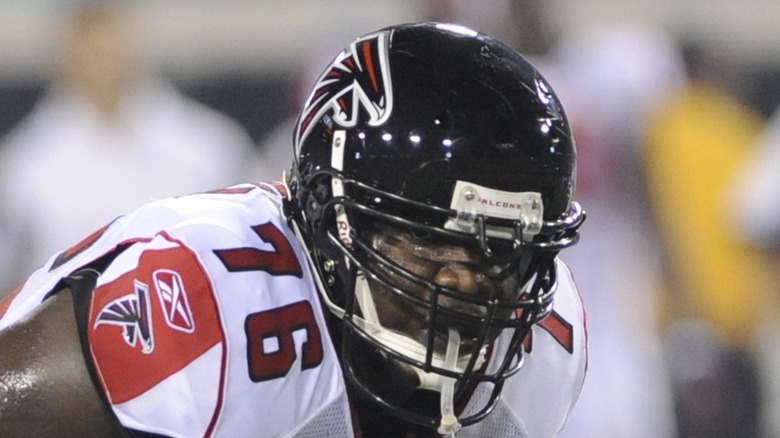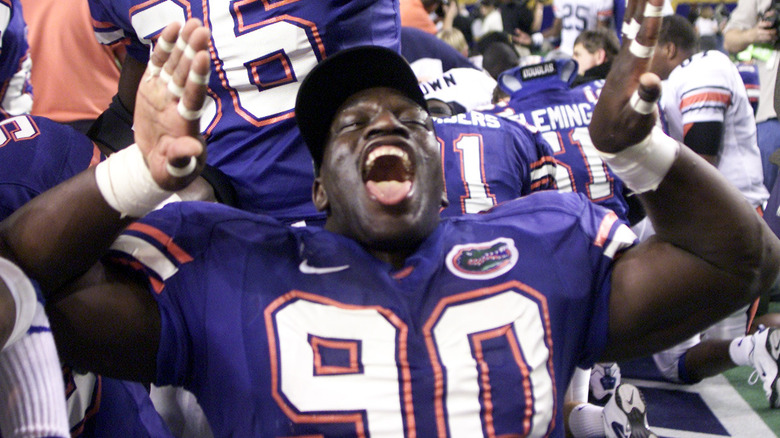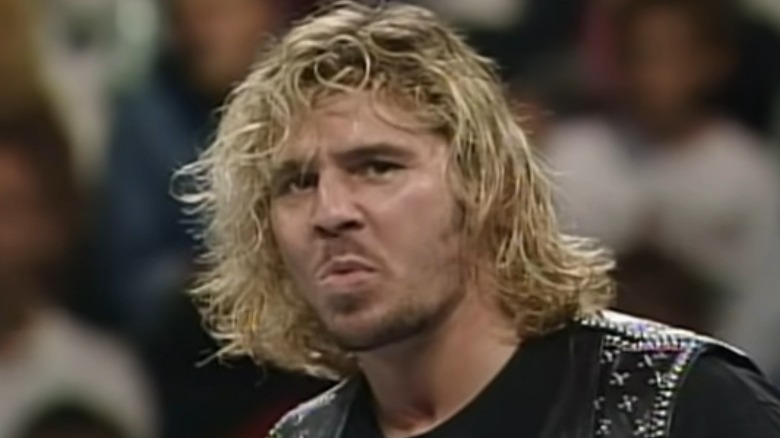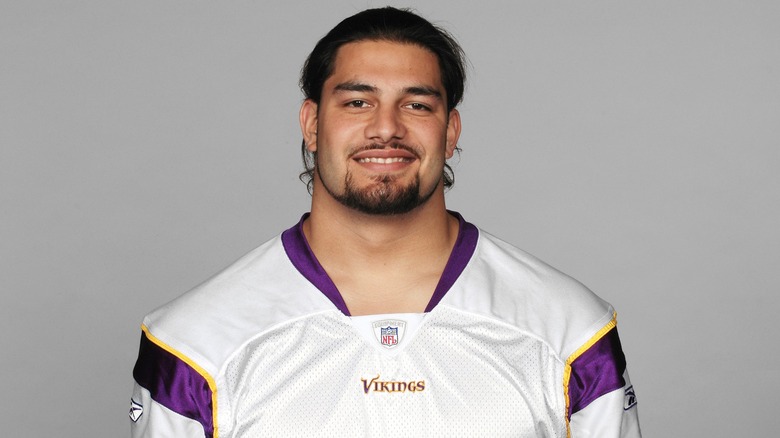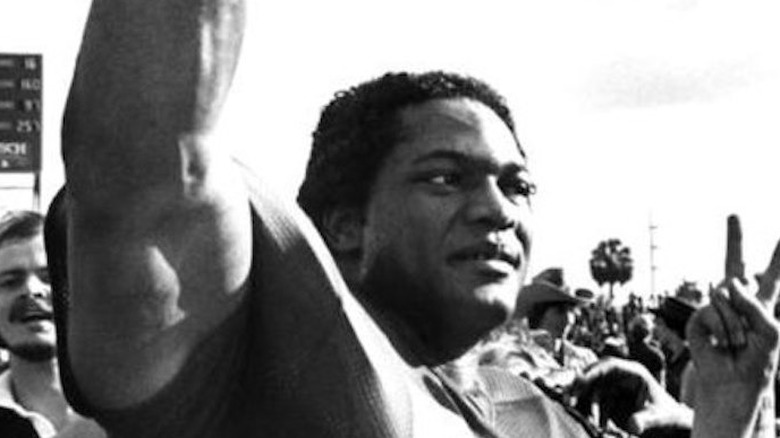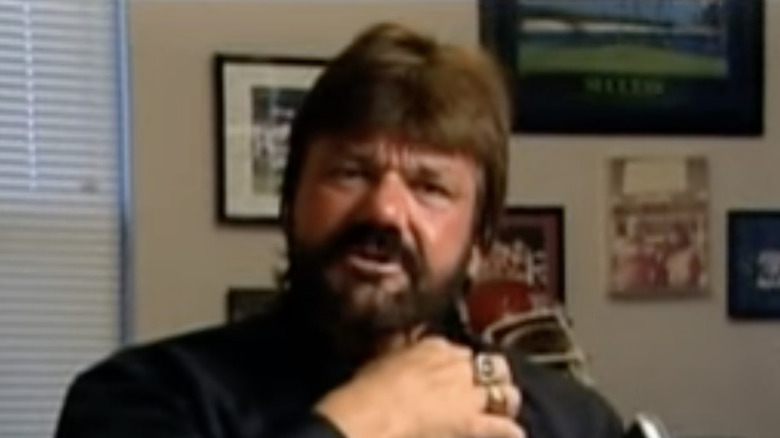Wrestlers With A Background In Pro Football
We may receive a commission on purchases made from links.
Professional football and professional wrestling are two athletic careers that have been linked for decades. Several achieved successful careers on the gridiron before ever stepping foot in a wrestling ring. The physical attributes it takes to play football has often made for a smooth transition into pro wrestling. The combination of explosivity and toughness in football players lends itself well to the goings-on inside a wrestling ring. Additionally, football players come in many different shapes and sizes, as have some of the world's greatest wrestlers.
The relationship between football and wrestling is as strong as ever in the modern era. Former players such as DeAngelo Williams and Adam "Pacman" Jones have shown just how seamlessly football players can pick up the craft, but many others have gone on to become household names in the industry.
Here are 18 wrestlers with a background in pro football.
Monty Brown
Former TNA standout Monty Brown may not have been on professional wrestling television for more than five years, but "The Alpha Male" certainly made the most of his time and eventually earned a WWE contract in 2006. However, Brown's NFL career, while also short, might have been even more impressive. Brown starred as an NCAA Division II All-American at Ferris State University in his native Michigan, where he entered the record books in several statistical categories. He also closed his collegiate career as an Academic All-American and an AP All-American. Brown then completed the improbable when he made the jump from Division II to the NFL, but the transition had its obstacles, even for a player as decorated as Brown.
"I didn't get an invitation to the NFL Combine, so every week different teams would come to my school and I had to be prepared to do whatever they wanted –- run, jump, psychological exams, etc.," Brown told TNAWrestling.com back in 2004. "Every week I would have to be at my best. I was running 4.5's for these guys and jumping 40-inch verticals, and unbeknownst to me I was generating numbers that –- had I been invited to the NFL combine –- they would have put me among the top three linebackers in the country." Brown proved to be worth his salt on the gridiron. He signed as an undrafted free agent with the Buffalo Bills in 1993, the tail end of the team's historic run in the early '90s. He suited up for the Bills at Super Bowl XXVIII and went on to earn a starting job with the New England Patriots in 1996. Brown's Patriots tenure started strong, but a significant ankle injury put him out of commission. He retired from football soon after, setting him on the course to becoming a pro wrestler.
Bruiser Brody
Frank Goodish, better known to wrestling fans as Bruiser Brody, had a knack for getting himself into trouble. Brody has a little known football career, but his off-the-field antics ultimately pushed him into the objectively crazier world of wrestling. According to Dave Meltzer's obituary for Brody, the former Frank Goodish started his career as a defensive end at Iowa State University in 1964 but transferred to West Texas State after getting removed from the Cyclones roster for "bad behavior." West Texas State, which is today known as West Texas A&M University, is a football program with a long lasting link with the wrestling business. Brody played on the same Buffaloes team that featured Terry Funk and Dusty Rhodes as offensive linemen and longtime NFL standout Mercury Morris at running back. Bobby Duncum also starred for the Buffaloes during these years as an All-American linebacker.
Brody went undrafted in 1968 but quickly signed on with the Washington Redskins' practice squad where he spent the next three seasons under legendary head coaches Otto Graham, Vince Lombardi, and George Allen. Meltzer reported that Brody was cut for bad behavior once again before meeting a similar fate as a member of the Edmonton Eskimos of the Canadian Football League. With the NFL and CFL having deemed the future Bruiser Brody as too much of a behavioral problem, Brody transitioned to semi-pro football in Texas where he was "discovered" by Ivan Putski, who along with Fritz Von Erich helped him break into the wrestling business.
Dick the Bruiser
William Afflis' metamorphosis into the feared Dick the Bruiser makes for a beautiful pro wrestling origin story. The Bruiser fell in love with professional football at an early age but when his family became impoverished after his mother lost her job in Indianapolis, he took up residence at the local YMCA in nearby Lafayette so he could join the athletic programs at Lafayette Jefferson High School. The Bruiser also partook in amateur wrestling, but gained a particular affinity for football. He went on to play at the next level for Purdue University and the University of Nevada, Reno as a guard, tackle and defensive lineman.
The Green Bay Packers drafted the future Dick the Bruiser 186th overall in the 16th round of the 1951 professional football draft. The Bruiser became a fixture in the Packers' lineup, earning the nickname he would use in pro wrestling while appearing in all 48 regular season games between 1951 and 1954. However, the Bruiser's run with the Packers came before their heyday under Lombardi, as the team never finished higher than fourth during his tenure. One game, the Bruiser took a hard shot to the neck, crushing his larynx and leaving him speechless for the next six months. When his voice did return, it came back more gravelly than before, a distinguishing characteristic of his wrestling persona. The Bruiser linked up with trainer Verne Gagne immediately after his football career came to a close, completing the lifelong transition from William Afflis to Dick the Bruiser.
Baron Corbin
One of the major revelations in Baron Corbin's feud with Pat McAfee in summer 2022 was that the two had actually been teammates for a brief period of time on the Indianapolis Colts in 2009. Corbin, real name Tom Pestock, signed with the Colts after going undrafted in 2009, but a prolific Division II career preceded his NFL and WWE ambitions. Corbin attended Northwest Missouri State University, an NCAA Division II college starting in 2004. The offensive guard earned a starting job ahead of his junior year in 2007 and proceeded to help his team in a major way. Corbin went to the Division II National Championships four times as a member of the Bearcats with the team, falling each time like a modern day Buffalo Bills. While at Northwest Missouri State, Corbin became an all-MIAA honorable mention in 2007 and first-team all-MIAA player in 2008, setting him on a course towards the NFL.
Corbin landed with the Colts and roomed with McAfee, the team's punter, until the team made him a training camp cut ahead of his would-be rookie season. Corbin resurfaced as a member of the Arizona Cardinals, spending time on their practice squad until his 2011 release. Corbin, who trained and competed in Golden Gloves boxing on the side while in college, opted for pro wrestling. He signed with WWE in 2012 in the same recruitment class as former Cardinals teammate Dean Muhtadi, who later became Mojo Rawley in NXT.
Bill Goldberg
Prior to his meteoric rise as in World Championship Wrestling in the late '90s, Bill Goldberg made a name for himself as a defensive lineman who played for a small handful of NFL teams. Goldberg spoke glowingly of his time in the sport during an appearance on the "Pat McAfee Show," mentioning he always hoped to follow his two older brothers who played college football. After a standout high school career, Goldberg earned a scholarship with the University of Georgia, one of the premier programs in the country, where he played defensive tackle. At the conclusion of his college career, the Los Angeles Rams selected Goldberg in the 11th round of the 1990 NFL Draft, back when the draft lasted for 12 rounds instead of seven.
Goldberg would log a stint with the Sacramento Gold Miners of the CFL before returning to the NFL as a member of the Atlanta Falcons. As a member of the Falcons, Goldberg played alongside NFL greats such as Jesse Tuggle, Deion Sanders, and Jamal Anderson. He went on to be taken in the 1995 expansion draft by the Carolina Panthers. However, Goldberg's NFL career came to an end when he "tore his lower abdomen off his pelvis." As a result, he never played a down for the fledgling Panthers. "In between playing football and wrestling I power lifted, actually I never intended on wrestling," Goldberg told IGN. "In my rehab, I intended on going back to football, and unfortunately, with my lack of success at what I did in the NFL I wasn't a huge asset, so it wasn't like I had a lot of teams knocking down my door." While he lamented his football career coming to a premature close, pro wrestling helped breathe new life into Goldberg's athletic career.
The Rock
Football had a major role in the story of Dwayne "The Rock" Johnson. Before he became The Rock, or even Flex Kavana, Johnson took up football at Freedom High School in the Lehigh Valley as a means of keeping himself out of trouble. He rose up the ranks and finished his high school career as one of the top defensive tackles in the country, signing on to play in college at the University of Miami on a full athletic scholarship. However, Johnson had his ups and downs at "The U," largely due to a lack of opportunity. Johnson played alongside Hall of Fame caliber players such as Ray Lewis and Warren Sapp, with the latter blocking him for playing time at defensive tackle. As a result, Johnson's collegiate numbers were limited, resigning him to a likely career in the CFL as opposed to the NFL.
The Calgary Stampeders signed Johnson out of college with the intention of changing his position to linebacker. However, the Stampeders cut Johnson two months into the 1995 season, putting his football career on ice. Two days after being cut by the Stampeders, Johnson found himself dejected and depressed back at his parents' house in Miami with all of seven dollars to his name. The moment of self-reflection became the inspiration behind the name of his production company, Seven Bucks Productions. "You gotta have faith that the one thing you wanted to happen oftentimes is the best thing that never happened," Johnson said in a video on his Instagram account.
Ernie Ladd
Best known in wrestling circles for his time in the WWF as well as Mid-South Wrestling, "Big Cat" Ernie Ladd is also one of the greatest football players to ever step foot in the ring. The 6'9 Louisiana-native signed to Grambling State University, an HBCU, on a basketball scholarship. However, he also played football for the Tigers and became just as prominent an athlete on the gridiron, if not moreso. Ladd bulked up to nearly 290 pounds and due to his imposing nature got drafted in both the NFL (Bears) and AFL (Chargers) drafts of 1961 during the pre-merger era when players could choose to sign in either league. He ultimately chose to sign with the San Diego Chargers of the AFL.
Though Ladd would have prototypical size and physicality for lineman of today's day and age, he played in an era where players were much smaller. As a result, he stood out as one of the biggest and strongest players of his time. Alongside teammates Ron Nery, Bill Hudson, and Earl Faison, Ladd made up the original "Fearsome Foursome." The Chargers rode their strong defensive line play to four AFL championship games during Ladd's time on the team, winning the title in 1963. Over time, the outspoken Ladd would frequently clash with the Chargers' front office, threatening a full-time move to professional wrestling, an offseason hobby of his. Ladd would log stints in Houston and Kansas City between 1966 and 1968 before ultimately making the move to wrestling.
Lex Luger
Many have made the decision to turn in their football cleats for wrestling boots, but few completed the shift as quickly as Lex Luger. "The Total Package" played his last game as a member of the Jacksonville Bulls on June 23, 1985 and made his debut for Championship Wrestling from Florida two months later. A former Division I football talent under his real name, Larry Pfoehl, Luger committed to Penn State University as an offensive lineman before transferring to the University of Miami. As a member of the Hurricanes, Luger played alongside future Pro Football Hall of Fame quarterback Jim Kelly and future famed college coach Mark Richt. However, Luger would not be long for Miami, as he snapped and trashed his hotel room in retaliation for Head Coach Lou Saban's decision to exclude him from the starting lineup. As a result, Luger would have to embark on an unorthodox path to the NFL.
Luger met a scout with the Montreal Alouettes of the CFL through a mutual friend and at 19-years-old inked a deal to play professionally in Canada. Luger played in Montreal for three years and helped the Alouettes to the 67th Grey Cup in a losing effort to the Edmonton Eskimos. However, he played well enough up north to earn a shot in the NFL with the Green Bay Packers, though he never suited up for the organization. He went on to spend the lion's share of his career in the United States Football League (USFL), a spring league that briefly attempted to compete with the NFL. Luger spent the 1984-85 season with the Memphis Showboats where he first became acquainted with wrestling. "I was getting mistaken and stopped all the time [and asked] if I'm a pro wrestler in Memphis, which made me think about maybe looking into wrestling," Luger told Devon Hannibal Nicholson of "THE HANNIBAL TV." "We had [wrestling] on in the locker room and the guys would go, 'you'd be great at that,' which appealed to my ego back then. 'Maybe I would be good at that.'"
Junkyard Dog
Sylvester Ritter, who would go on to be known as the Junkyard Dog in Mid-South Wrestling and the WWF, had an oft-forgotten pro football career prior to his run on the territories. JYD starred collegiately as an offensive lineman at Fayetteville State University, an HBCU. JYD was no slouch, receiving All-NAIA team for his freshman, sophomore, and junior seasons. As a senior, he would be named to the All-CIAA football team and chosen to the All-Star football team as an offensive lineman.
JYD tried his hand at the NFL, and wound up with the Houston Oilers organization. However, he failed to catch on at the next level, with recurring knee injuries ultimately doing him in. Following an abbreviated stint with the Green Bay Packers that saw him participate in nary a workout, JYD would again find himself on the outside looking in of the roster bubble. Rather than take a third crack at the league, JYD would turn to professional wrestling, training under Sonny King before getting his start with Memphis promoter Jerry Jarrett in 1977.
Pat McAfee
Not all roads from pro football to pro wrestling are created equal, but Pat McAfee's journey to pro wrestling is unique. The media mogul and part-time pro wrestler journey to the NFL began when he won the 2002-03 NFL Punt, Pass, and Kick competition. Later, he took out a $100 loan from a friend, turned it into $1,400 by way of an illegal poker game and traveled to Miami to enter a national competition for kicking prospects. McAfee went on to convert on seven consecutive field goals and soon found himself kicking for West Virginia University.
While many of the NFL's future punters end up without a team on Draft Day, this was not the case for McAfee, who landed with the Colts in the seventh round of the 2009 NFL Draft. A teammate of Hall of Fame quarterback Peyton Manning, McAfee kicked for the Colts for eight years before walking away from the sport after falling out with General Manager Ryan Grigson. However, McAfee successfully cultivated a sports broadcasting career that has seen him receive paychecks from the likes of ESPN, Fox Sports and Barstool Sports just to name a few companies. After building a name for himself in sports media, McAfee, a lifelong wrestling fan, linked up with WWE at WrestleMania 35 when he appeared on the kickoff show. He has since gone to appear as a color commentator on Smackdown alongside Michael Cole and has wrestled a handful of matches in NXT and on the main roster.
Wahoo McDaniel
While many football players got involved with pro wrestling in retirement, the legendary Wahoo McDaniel juggled both careers during his football prime. McDaniel's time in football dates back to his days as a teenager. He was a terrific athlete, competing in baseball and track & field as he looked up to multi-sport athlete and fellow Oklahoman and Native American Jim Thorpe. His versatility translated to the football field where he starred at both offensive guard and linebacker even into his pro career.
Countless stories have been told of McDaniel's time at Oklahoma, but the experience netted him the chance to play professionally. Like his contemporary Ernie Ladd, McDaniel landed with the Chargers, albeit the year before the team relocated to San Diego. McDaniel then ended up with the Houston Oilers, a team that went on to win the inaugural league championship. Like many during this era, McDaniel bounced between the NFL and AFL before retiring in 1968 to devote himself to wrestling full-time. Both football and wrestling catered to McDaniel's strengths as an athlete, but he once admitted to Sports Illustrated that wrestling presented the greater challenge. "People can believe what they want, but what I experienced in the ring was as tough or tougher than anything I encountered on a football field," McDaniel said. "Rougher still was what wrestlers had to put up with outside the ring."
Steve 'Mongo' McMichael
In the case of former Chicago Bears defensive lineman Steve "Mongo" McMichael, his rise to stardom on the football field allowed him to transition naturally to a brief second career inside the squared circle. The nickname "Mongo" comes from the 1974 Mel Brooks movie, "Blazing Saddles," and McMichael became quickly recognizable on the football field for his high motor. He lettered in six sports in high school but stood out in football, earning 75 football scholarships his senior year. He chose to play for the Texas Longhorns and became one of the top Division I defensive linemen in the country. He was inducted into the College Football Hall of Fame in 2010.
McMichael's move to the NFL did not come as easy. "Mongo" was cut by the New England Patriots, the team that drafted him, in 1980, but signed with the Chicago Bears in 1981, clicking with Head Coach Mike Ditka. McMichael's Bears would ironically defeat the Patriots in Super Bowl XX, and he would go on to play with the Bears for another eight years. McMichael finished his career as a two-time pro bowler and is recognized by the Chicago Sun-Times as one of the greatest Bears of all time. He retired from the league in 1994 and made his first wrestling-related appearance in 1995 for the WWF in the main event of WrestleMania XI. However, "Mongo" and his wife, Debra, signed WCW contracts later that summer. Kevin Greene, a contemporary of McMichael's would also wrestle for WCW, but "Mongo" went on to be the more tenured wrestler of the two.
Moose
Quinn Ojinnaka, better known to wrestling fans as former Impact World Champion Moose, made every effort to become a successful pro football player before turning to an in-ring career. He attended DeMatha Catholic High School, a football power in his native Maryland and made All-Prince George County as an offensive lineman. He attended Syracuse University while becoming part of one of the greatest offensive lines in the history of the Orange. Moose started all 11 games his senior year and received an invite to play in the Las Vegas All-American Classic, an all-star game played for pro scouting purposes.
The Atlanta Falcons drafted Moose in the fifth round of the 2006 NFL Draft, and he appeared in 11 games as a rookie after being forced into action due to injuries on the active depth chart. He started seven games at left tackle during his second season in the league. He even appeared in a handful "Madden" installments, the top football video game franchise on the market. However, the Falcons traded Moose to the New England Patriots for a seventh-round draft pick in the 2011 draft. Ojinnaka had previously been suspended by the league for violating the league's dome Personal Conduct Policy. While in the league, Ojinnaka trained in mixed martial arts under Fox Sports' Jay Glazer, though he would ultimately choose pro wrestling over MMA after stints with the Patriots, Rams, and Colts.
Titus O'Neil
Titus O'Neil, real name Thaddeus Bullard, parlayed a solid Division I college football career into a four-year run in the arena league before becoming a "Prime Time Player" elsewhere. O'Neil used football as an escape from a tough childhood, and he became a key piece for the Suwannee Bulldogs high school football team. Publications such as USA Today and Parade Magazine recognized him as a high school All-American, paving the way for the Floridian to play college football for one of the state's most notable programs, the University of Florida.
O'Neil played under famed Head Coach Steve Spurrier between 1996 and 2000. He redshirted his freshman year to retain an extra year of eligibility, the same year the Gators defeated in-state rival Florida State University in the Sugar Bowl. O'Neil spent the next four years at Florida as a role player at defensive end, playing in nearly every regular season game while starting in three of them.
After going undrafted in 2001, O'Neil spent three years out of football before joining the Arena Football League as a member of the Las Vegas Gladiators. According to ArenaFan.com, O'Neil had his best season with the Gladiators in 2004, when he registered 22 total tackles (16 assisted) while racking up four sacks, two forced fumbles, and one fumble recovery. He also got involved on the offensive end in 2005, catching three passes for 23 yards and a touchdown.
Following the two-year stint in Vegas, O'Neil played sporadically for the Tampa Bay Storm and Utah Blaze before segueing into a pro wrestling career. His son, T.J. Bullard, recently committed to the University of Central Florida to play football.
Brian Pillman
Brian Pillman needed to overcome several obstacles to become the star he became in pro wrestling, but his career in football prepared him for every challenge that would come his way. He came into his own as a football player at Miami University (Ohio) where as a 5'10 defensive tackle floating around 200 pounds set the program's "tackle for loss" record. Pillman then overcame academic difficulties to become a Division I Second-Team All-American as a junior and a Division I All-American as a senior. A roommate of Baltimore Ravens Head Coach John Harbaugh while at Miami, Pillman was also named Mid-American Conference (MAC) Defensive Player of the Year in 1983.
Pillman went undrafted in the 1984 NFL Draft but caught on as a member of his hometown Cincinnati Bengals. As a Bengal, Pillman won his team's Ed Block Courage Award, a teammate-voted award reserved for players who are role models of inspiration, sportsmanship, and courage. Pillman set the tone for the Bengals with his work ethic and intensity, then headed north of the border to spend a season with the Calgary Stampeders of the CFL. Pillman would remain in Calgary to train pro wrestling under the legendary Stu Hart after being pushed in the direction of wrestling by former Bengals strength and conditioning coach Kim Wood. Wood revealed on "Dark Side of the Ring" that he thought wrestling would be a good alternative medium for Pillman to channel his physicality.
Roman Reigns
Many fans may know about Roman Reigns' college football roots. Reigns, real name Joe Anoa'i, spent four years at Georgia Tech and became a major part of the Yellow Jackets' defense from his sophomore year on. However, like his cousin Dwayne Johnson, Reigns aspired to play at the next level and even dabbled with the Canadian Football League as a last resort.
His journey began at Pensacola Catholic, where he was named Defensive Player of the Year by the Pensacola News Journal. From there, Head Coach Chan Gailey recruited Reigns to play for the Yellow Jackets along with classmate Calvin Johnson, who went on to have an outstanding career in his own right for the Detroit Lions. "We were team captains together," Johnson told Rich Eisen. "We kind of knew he had a little background [in wrestling] with his family ... but I don't think anybody knew he would take off and go from playing football to wrestling and be the star that he is." Reigns finished his college career on a high note. His teammates made him a captain his senior year and he starred for the Yellow Jackets' defense en route to being named to the first-team All-Atlantic Coast Conference in 2006. He also earned All-ACC first-team honors with 40 tackles, two recovered fumbles and 4.5 sacks, helping Georgia Tech to a 9-5 record as well as an appearance in the ACC Championship game.
The Minnesota Vikings signed Reigns out of college in 2007, but his first leukemia diagnosis (which was withheld from the public) put his football career on ice. One year later, Reigns caught on with the Edmonton Eskimos, recording just nine tackles in 18 games in his lone season north of the border. With his football career on life support, Reigns retired from the sport following the 2008 season and began to tap into his pro wrestling roots. "I always had that in the back of my mind and fully in my heart that I knew if football didn't work out, wrestling would be something that I know I could enjoy," Reigns told Carlos Pineda of SouthernPigskin.com. "It's something I could thrive in and become that star and be a difference maker in this world."
Ron Simmons
Former WCW World Heavyweight Champion Ron Simmons might not have the pro football accolades his predecessors Ernie Ladd and Wahoo McDaniel had, but he had as solid of a college career as any wrestler on this list. Florida State University Head Coach Bobby Bowden pursued the Georgia native out of high school, and his recruitment paid immediate dividends to the program. Simmons made a name for himself as arguably the best young defensive lineman in the country, earning the Freshman Lineman of the Year honor from The Football News. The Seminoles ranked as a top-20 program three times during Simmons' time with the team, and his junior year was so prolific he finished ninth in Heisman Trophy voting, an award typically reserved for offensive skill positions. He was inducted in the Seminoles Hall of Fame Class of 1986.
The Cleveland Browns drafted Simmons in the sixth round of the 1981 NFL Draft. Simmons would have likely gone higher, but at 6'1, 235 pounds he was considerably undersized compared to most NFL defensive tackles. He played for the Browns for two seasons under defensive coordinator Marty Schottenheimer, then left the NFL for alternative football leagues. Simmons continued his professional career with the CFL's Ottawa Rough Riders, then moved to the USFL to play for the Tampa Bay Bandits. While in Tampa, Simmons played alongside future WCW co-worker Lex Luger. He also met Tampa native Hiro Matsuda, a famed Japanese wrestler and trainer who trained Hulk Hogan and Scott Hall as well as Luger. Simmons trained for a year under Matsuda and made his debut for Jim Crockett Promotions.
Dr. Death Steve Williams
A favorite of longtime Oklahoma Sooners fan Jim Ross, "Dr. Death" Steve Williams is one of the greatest all-around athletes to arrive in pro wrestling after a career in football. Former University of Oklahoma wrestling coach Jack Spates called Williams (per the AP) "one of the greatest athletes that the University of Oklahoma has ever produced." Williams did it all for the Sooners, competing in wrestling as well as track & field and football. On the gridiron, Williams played both guard positions for the Sooners and became a full-fledged starter by his senior season. He was named to the UPI All-Big Eight first team as a senior. "Cowboy" Bill Watts discovered Williams during his days at Oklahoma and broke him into the wrestling business when his career with the Sooners came to an end.
However, Williams continued to play football even after making his Mid-South Wrestling debut in 1982. The USFL's New Jersey General picked Williams in the 1983 Territorial Draft and converted him to defensive tackle. Though a bruised knee landed Watts on injured reserve for the first six games of his rookie year, he went on to start games for the Generals at nose tackle down the stretch. However, the allure of pro wrestling became too much for Williams, leaving football for good at the conclusion of the 1983 USFL season. "I was always in awe of Doc as I had never seen a man of his size," longtime friend Jim Ross wrote on his blog. "He was 330 when he first signed with Watts while still a student at OU, with the quickness, flexibility and reflexes of this powerhouse."
